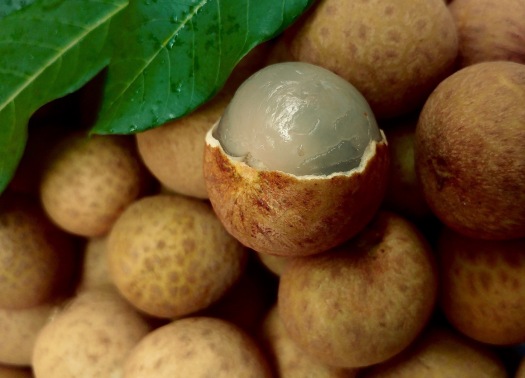One of the best ways to explore the gastronomic expanse of a new place is by trying out the new cuisine. And I often feel that fresh fruits are one of the most integral, yet underrated part of local food.
So here is a list of some of the unique fruits that you must try during your travels in and around Southeast Asia.
Rambutan:
Or the hairy lychee, is a very popular fruit in the southeast Asian region, and is native to the Malaysian archipelago. Because of its popularity, it is now being cultivated in parts of Central America, Africa, Australia and South India.
Its name is quite apt, since ‘rambut’ means hair in Bahasa Meyalu and Indonesia. Despite the outer peel’s appearance like Robert Pattison’s messy bed head, the fruit is juicy, delicious and tastes very similar to the lychee.

Where to find it: The rambutan is easily available in grocery stores/ supermarkets and local fruit markets across Southeast Asia.
Longan:
Another popular cousin of the lychee, the Longan is a round fruit with a brownish peel that hardens as the fruit ages. Longan in Cantonese means ‘dragon eye’, which is quite an apt name for this fruit, as it looks like a giant eye once the skin is peeled off.
Historically, the fruit was grown in China, but it is now well-known all over the world, and is grown in parts of the USA, Australia, the Indian subcontinent, and across Southeast Asia. It is sweet and juicy like the lychee, and is often used to make desserts, jellies and a refreshing summer drink. It is also used in traditional Chinese medicine due to its (supposed) health benefits.

Where to find it: The longan fruit and its products are easily available in grocery stores/supermarkets and local fruit markets across Southeast Asia. Longan juice can also be easily found at most beverage stalls in food courts and/or restaurants.
Dragonfruit:
The dragonfruit or ‘pitaya’ is an intimidating looking fruit native to South/Central America, which is commonly produced in Southeast Asia. What makes this fruit unusual is the fact that it is produced by a cactus plant, and that its flower, which is pollinated by bats, blooms only for one night before wilting!
There are three varieties of dragon fruit, and the most common one has a reddish pink exterior with white flesh. The texture and taste of the fruit is like that of the kiwi – interspersed with tiny black seeds, though it is less sour!
This unique fruit is considered as a super fruit with tons of health benefits, so that’s just another reason to try it out.

Where to find it: The white flesh dragon fruit is easily available in grocery stores/supermarkets and local fruit markets across Southeast Asia. You may be lucky to come across the pink flesh dragon fruit occasionally, though yellow exterior dragon fruits are a rarity in this region.
Mangosteen:
This sweet and tangy tropical fruit is commonly known as the ‘Queen of Fruits’ and is not easily available outside Southeast Asia. In fact, until 2007, the USA had banned the import of mangosteen, as the fruit is a potential carrier of fruit flies.
Several countries have tried to cultivate this fruit, but most have been unsuccessful and this fruit is mostly limited to Asia. The largest producers of mangosteen today are Thailand, Malaysia, Indonesia and Philippines.
Trivia aside, this is one of the most delicious fruits I have ever tasted, and certainly not to be missed. Be careful while eating though, the purple rind can leave stains that are almost impossible to remove.

Where to find it: The mangosteen is easily available in grocery stores/ supermarkets and local fruit markets across Southeast Asia.
Durian:
No list of Southeast Asian fruits is complete without a mention of the King of Fruits – Durian. It looks like a mix between a jackfruit and pineapple, though it tastes like nothing I have ever tasted before. In my opinion, you either love the fruit or hate it, and most newbies would generally believe in the latter, as it is definitely an acquired taste.
You will generally smell the durian before you see it – it isn’t known as the smelliest fruit in the world for nothing 😉 In fact, it’s so smelly that it isn’t allowed on public transport or in elevators in Singapore.
That being said, it remains one of the most unique fruits of the southeast Asian region, and a trip isn’t complete without tasting this bizarre fruit.

Where to find it: The durian is easily available in grocery stores/ supermarkets and local fruit markets across Southeast Asia. Durian flavoured ice cream is also quite popular and can be found in supermarkets.
Salak:
With an outer covering that looks like snake skin, the salak is fondly known as the ‘Snake Fruit’ and is one of the many unique fruits that belong to the lychee family.
Its shape and size is similar to that of a lychee, but taste is where the salak is starkly different from the rest of its family. It has a crunchy texture with a slightly acidic aftertaste – nothing like a lychee. In fact, a closer comparison would be the rose apple (another common Asian fruit).

Where to find it: The salak is easily available in grocery stores/ supermarkets and local fruit markets across Indonesia. It is also a common breakfast item available in hotel buffets across the country.
In all my travels, if there is one type of culinary tour I have found missing, it is a tasting session of local fruits. So I generally go to the markets and try the fruits out myself! After all, travelling isn’t just about visiting new places; it is also about experimenting with the local produce, right?
How many of these unique fruits have you tried? Tell me in the comments below!


One Reply to “”